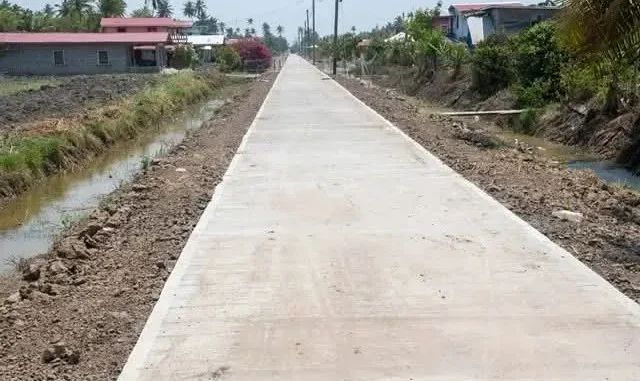
Guyana Govt promises to rectify narrow concrete roads in Berbice
Guyana Govt promises to rectify narrow concrete roads in Berbice. The Guyanese government has initiated a comprehensive plan to address the longstanding issue of narrow and deteriorated concrete roads in Berbice. This initiative encompasses a series of substantial investments aimed at enhancing the region’s infrastructure, thereby improving accessibility and fostering economic growth.
Extensive Investment in Road Rehabilitation
In September 2022, the government demonstrated its commitment by signing 268 contracts valued at $8.6 billion for road repairs across Region Six (East Berbice-Corentyne). This decision was influenced by numerous complaints from residents regarding the poor state of community roads. Vice President Dr. Bharrat Jagdeo highlighted that for nearly a decade, minimal investment had been made in community infrastructure. He emphasized the government’s policy to allocate oil revenues towards capital expansion projects, including roads and schools, to address these deficiencies.
To expedite the rehabilitation process and ensure widespread participation, over 200 contractors, both large and small, were engaged. The government opted for the construction of concrete roads over asphaltic ones, citing the minimal skills and supervision required for concrete construction. Dr. Jagdeo urged contractors to adhere strictly to project specifications, warning that substandard work would result in exclusion from future contracts. He also called upon the Neighbourhood Democratic Councils (NDCs) to monitor the quality of work, ensuring that residents receive durable and reliable infrastructure.
Ongoing and Future Projects
The momentum continued into 2023, with the Ministry of Public Works signing contracts exceeding $1.9 billion for the rehabilitation of roads across Region Six. These projects, categorized under miscellaneous and urban roads programs, involve upgrading existing alignments to either asphaltic concrete, rigid pavement, or concrete pavement. Public Works Minister Juan Edghill emphasized the importance of timely completion, urging contractors to stockpile materials before commencing construction to minimize inconvenience to residents. He also highlighted the necessity of community engagement, instructing engineers and contractors to meet with local communities, provide unpriced bills of quantity, and inform residents about project timelines.
Specific Road Upgrades and Community Impact
Several key projects have been identified to transform the infrastructure landscape in Berbice. For instance, the rehabilitation of Pepper Street in Heathburn Village involves converting a mud dam into an asphaltic concrete road spanning approximately 1,000 meters. Similar upgrades are underway in Temple (Steve Street) in East Canje and Kuldeep Street in Betsy Ground, aiming to enhance connectivity and accessibility for residents. These projects are part of the government’s broader vision to provide significant relief to citizens, reduce transportation congestion, and stimulate economic development.
Regional Developments and Broader Implications
The commitment to infrastructure development extends beyond Berbice. In Region Five (Mahaica-Berbice), the Ministry of Public Works signed 21 contracts valued at $1 billion to rehabilitate 25 roads. Minister Edghill reiterated the government’s dedication to simultaneous development across all regions, aligning with President Dr. Mohamed Irfaan Ali’s directive to ensure equitable infrastructure improvements nationwide. These projects are expected to be completed within a three-month timeframe, demonstrating the administration’s urgency in addressing infrastructural challenges.
Community Engagement and Quality Assurance
A critical component of these initiatives is the emphasis on community involvement and quality assurance. Residents have been encouraged to actively participate in the development process, attending meetings where engineers provide project details and timelines. This transparency fosters a sense of ownership and ensures that the infrastructure meets the community’s needs. Contractors have been instructed to maintain open communication with residents, addressing concerns promptly and ensuring that construction activities cause minimal disruption. The government’s proactive approach in engaging local communities underscores its commitment to delivering projects that not only enhance infrastructure but also improve the quality of life for its citizens.
Challenges and Solutions
Despite the ambitious scope of these projects, challenges such as limited contractor availability and ensuring adherence to quality standards have been acknowledged. The government’s strategy to encourage the construction of concrete roads, which require less specialized skills, aims to mitigate these issues. By diversifying the pool of contractors and providing clear guidelines and supervision, the administration seeks to ensure that infrastructure projects are completed efficiently and to a high standard. This approach not only addresses immediate infrastructural needs but also builds local capacity for future development initiatives.
Conclusion
The government’s proactive measures to rectify narrow and deteriorated concrete roads in Berbice reflect a broader commitment to national infrastructure development. Through substantial investments, strategic planning, and community engagement, these initiatives aim to enhance connectivity, stimulate economic growth, and improve the daily lives of residents. As these projects progress, they are poised to transform the infrastructural landscape of Berbice, setting a precedent for future developments across Guyana.
Leave a Reply